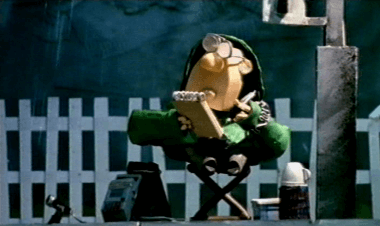25 Years of the McLaren Award 1995-1999
In our first retrospective celebrating 25 years of the Edinburgh International Film Festival’s McLaren award, we saw various films that held the spirit of the awards namesake Norman McLaren in their own individual manner using various styles and themes. between the years 1995 and 1999 the award appears to have been handed out to a more lighthearted, yet equally brilliantly executed set of films that not only represent the flavour of British animation at the time but also some of McLarens more lighthearted and playful moments. You can be an artist whilst still having a little fun and there is no better form than that of animation to do so. The films in this selection represent the shape of UK animation at the time with some names that continue to be a part of the animation scene to this day. In this selection we see Peter Peake take the leap from Aardman animator to director, winning twice with Pib and Pog and Humdrum and Oscar winning animator Daniel Greaves takes a well deserved win with Flatworld. Trainspotter is perhaps the first time the industry would have heard of Neville Astley who would later form Astley Baker Davis creating the phenomenon that is Peppa Pig and his co-director Jeff Newitt who also directed the superb Loves Me, Loves me Not and relatively recently co-directed the Pirates in an Adventure with Scientists with Peter Lord. Tim Hope is still a director with Passion Pictures dealing with live action and mixed media and has produced probably the best music video featuring murderous mallards you’ll ever see. So lets take a trip with some of the Skwigly writers back in time between 1995 and 1999 to find out more about worthy winners in an era when UK animation had a little fun. 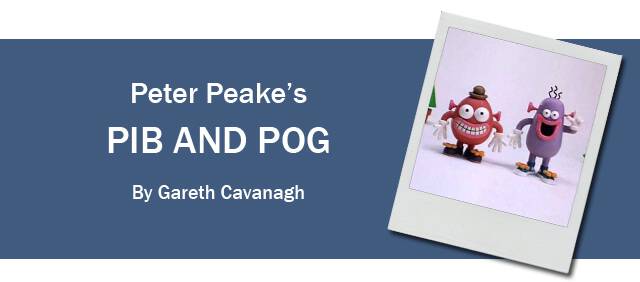 It’s not often that an animation featuring limb dismemberment, point-blank gunshot wounds to the abdomen, chemical-solution disfigurement and eventual disintegration by cannon, can raise actual belly-laughs, but Pib and Pog is no ordinary cartoon. I must admit that I jumped at this opportunity to write about Peter Peake’s 1995 McLaren winning short. My first experience of Pib and Pog was whilst on my Animation degree course in GCADT, South Wales in 1997. A darkly witty, twisted take on pre-school kids TV with lashings of Itchy and Scratchy levels of comic violence and Tex Avery style extreme, animated takes, it has remained one of my favourite animated shorts for the last (almost) two decades. Pib and Pog, our two bulbous eyed, plasticine protagonists/antagonists, are introduced to us via the plummy-tones of our “Watch with Mother” style host, who has a habit of comically underplaying the violent acts we are observing. Pretty soon, they are bickering and squabbling over a sea-shell and before you can say “boy, that escalated quickly” said limbs have been flayed, Uzi’s have been fired, buckets of acid have been produced, characters have been sawn in half and eventually blown to plasticine heaven, only to reconstitute without a scratch, “just in time to sing the Pib and Pog song”. As a final reveal, we discover that Pib and Pog are merely characters played by two hammy thespians who exit into the horizon complaining about their working environment, “I don’t expect Morph has to put up with these kinds of conditions!”
It’s not often that an animation featuring limb dismemberment, point-blank gunshot wounds to the abdomen, chemical-solution disfigurement and eventual disintegration by cannon, can raise actual belly-laughs, but Pib and Pog is no ordinary cartoon. I must admit that I jumped at this opportunity to write about Peter Peake’s 1995 McLaren winning short. My first experience of Pib and Pog was whilst on my Animation degree course in GCADT, South Wales in 1997. A darkly witty, twisted take on pre-school kids TV with lashings of Itchy and Scratchy levels of comic violence and Tex Avery style extreme, animated takes, it has remained one of my favourite animated shorts for the last (almost) two decades. Pib and Pog, our two bulbous eyed, plasticine protagonists/antagonists, are introduced to us via the plummy-tones of our “Watch with Mother” style host, who has a habit of comically underplaying the violent acts we are observing. Pretty soon, they are bickering and squabbling over a sea-shell and before you can say “boy, that escalated quickly” said limbs have been flayed, Uzi’s have been fired, buckets of acid have been produced, characters have been sawn in half and eventually blown to plasticine heaven, only to reconstitute without a scratch, “just in time to sing the Pib and Pog song”. As a final reveal, we discover that Pib and Pog are merely characters played by two hammy thespians who exit into the horizon complaining about their working environment, “I don’t expect Morph has to put up with these kinds of conditions!”
Created at Aardman and distributed by Channel 4, the short was Executive produced by Peter Lord, David Sproxton and Carla Shelley and as well as the 1995 McLaren, it was presented with the Edinburgh International Film Festival Award for Best New British Animated Film and was Nominated for a BAFTA Film Award for Best Short Animated Film in the same year. Although raised on a diet of Looney Tunes and Tom & Jerry cartoon violence there was something about witnessing it in the medium of stop-motion that brought freshness to the comedy. Maybe, because it was released in an age before social-media sharing, before the term viral meant something other than illness and even though the characters were eventually employed to advertise a certain brand of cheese-spread, it still hasn’t worn out its welcome and stylistically hasn’t aged a single day. All together now! “Pib and Pog, Pog and Pib, lots of fun for every kid. “ 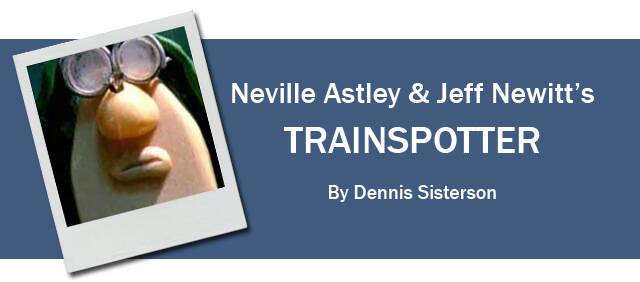 To me, this is a perfect little film. It’s no surprise, watching this, that its two directors went on to glowing careers. Jeff Newitt went to Aardman and co-directed “The Pirates”. Neville Astley, of course, has his hands full looking after pigs and elves.
To me, this is a perfect little film. It’s no surprise, watching this, that its two directors went on to glowing careers. Jeff Newitt went to Aardman and co-directed “The Pirates”. Neville Astley, of course, has his hands full looking after pigs and elves.
We’re treated to the sight, still not uncommon in England, of a rather sad-looking man patiently waiting in a station platform with a notebook, in the rain, for no greater reward than the serial number of a passing train. Despite his careful preparation he manages to miss several, and it’s not until he finally succeeds that we realise he’s even more dedicated, and not as slow-witted, as we thought.
It’s a masterpiece of comic timing and simple but effective model animation, as every little gesture of the character, and every rainy second that passes by as he waits for his trains, makes us feel for him a little more. The punchline – with an extra little gag thrown in for good measure – is a little tribute to anyone who has spent long hours dedicated to a profitless and tedious passion that few can truly understand. We can relate to that, can’t we? 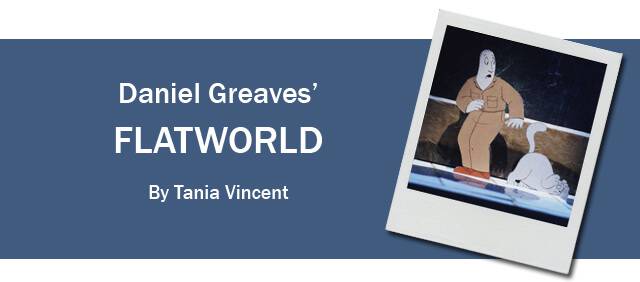 Most animators will remember the first time they saw Flatworld. It is one of those classic shorts that combine everything us artists love. A great idea, brilliantly executed that lets the imagination run wild. Although most of us have spent many year honing our craft there is still that childhood wonder inside that allows us to imagine our drawing leaping and running off the page. It was no surprise when Flatworld won the McLaren award in 1997. This creative piece, written and directed by Daniel Greaves, wonderfully displays stop motion and traditional drawings to make an interesting and compelling film. The melding of these two techniques makes every frame of this short worth a watch. For those of you who may not have seen this short (and please go and watch it the second you stop reading) the story follows Matt Phlatt (pun fun for all the family), his cat Geoff and his fish Chips who live in a three dimensional stop motion world while being made out of flat paper drawings. While working in the street and fixing some wiring Matt causes a freak electrical accident that allows his doppelgänger and 30’s TV ganger to escape from the silver screen. This gangster goes on a criminal rampage and poor look-alike Matt gets into trouble. This film is reminiscent of the Looney Tunes animation Duck Amuck and shows different way you can manipulate a medium.
Most animators will remember the first time they saw Flatworld. It is one of those classic shorts that combine everything us artists love. A great idea, brilliantly executed that lets the imagination run wild. Although most of us have spent many year honing our craft there is still that childhood wonder inside that allows us to imagine our drawing leaping and running off the page. It was no surprise when Flatworld won the McLaren award in 1997. This creative piece, written and directed by Daniel Greaves, wonderfully displays stop motion and traditional drawings to make an interesting and compelling film. The melding of these two techniques makes every frame of this short worth a watch. For those of you who may not have seen this short (and please go and watch it the second you stop reading) the story follows Matt Phlatt (pun fun for all the family), his cat Geoff and his fish Chips who live in a three dimensional stop motion world while being made out of flat paper drawings. While working in the street and fixing some wiring Matt causes a freak electrical accident that allows his doppelgänger and 30’s TV ganger to escape from the silver screen. This gangster goes on a criminal rampage and poor look-alike Matt gets into trouble. This film is reminiscent of the Looney Tunes animation Duck Amuck and shows different way you can manipulate a medium.
It has many nods to the animators watching and doesn’t dumb its plot or story down for a non-artistic audience. The idea of animating a 2D animation or stop motion animation on its own is a daunting task so I think many animators love for this piece comes from the overwhelming urge to understand why anyone would take on such a momentous task. Of course Daniel Greaves is not just any animator and has strived his whole career to create something different that not only stands out from the crowd but baffles all who are watching. His other projects include such classics as Manipulation, Little Things and Rockin’ and Rollin’. Daniel Greaves doesn’t just rely on his impressive animation techniques but adds small touches and well thought out details to create a believable and fun environment. Things such as the police officer using a staple gun, Geoff the cat accidentally falling into the 2D colourful world of the TV where different animation principles apply or the paper thin ability to hide out of plain sight just by turning to the side, make this film a unique and fun short. The impressive techniques used in this movie such as the presence of weight and the use of lighting add to its grand concept. Geoff the cat’s large paws seem so heavy and realistic even though they are thin paper, the calm dark world that Matt lives in is juxtaposed brilliantly with the colourful world of the TV. The lighting techniques combined with the paper environment create a believable world that audiences wanted to see more of. Most animators get excited to watch this movie so it was no surprise when it won the Edinburgh film festival award and was nominated for a Bafta back in 1997. Luckily for fans of this short, Daniel Greaves newest work Mr. Plastimime will be released in 2014 and will be using similar techniques and promises to be as exciting as his previous works. 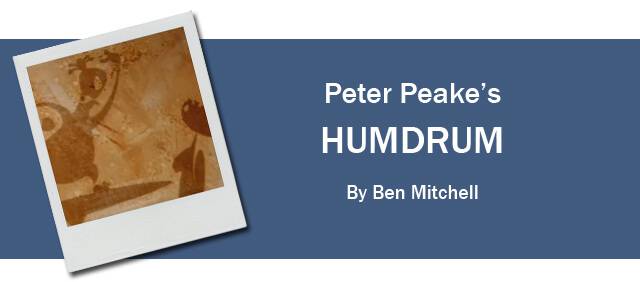
“Anything on the telly?”
“Only some weird animation thing.”
“Oh God…”
Though elements of the film – the music, predominantly – root it in the late nineties, the visual approach has given it a contemporary edge that has yet to truly date. With ingeniously thought-through cutout character animation projected onto grim, textural backdrops, the resulting ‘shadow puppet’ effect of the film is a fantastic demonstration of what makes an animated short truly stand out from the crowd, especially when combined with its splashes of metaphysical self-effacement and wry surrealism.
Voicing the two Scottish roommates – one needlessly put-upon, the other needlessly jovial – are Moray Hunter and Jack Docherty of Absolutely, who exchange a series of non-sequiturs before succumbing to a doomed game of ‘Shadow Puppets’ (“I can’t think of anything more boring” bemoans the more world-weary of the two). The absence of exposition or resolution in the story is largely – and joyfully – the point, and didn’t stop it from performing exceptionally well, winning multiple awards across the globe and earning itself an Oscar nomination. Ultimately it contributed to the wider identity of a post-Wallace & Gromit Aardman as being able to produce quality short films, a reputation maintained by many filmmakers including Luis Cook (Pierce Sisters), Alan Short (Fly), Nigel Davies (Blind Date) and, twelve years later, Peake himself (Pythagasaurus).
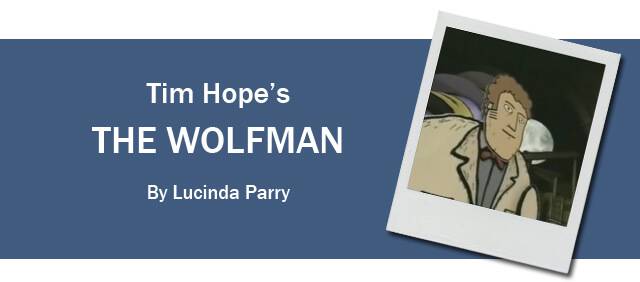 The Wolfman is a film that I first saw in my third year of university. It was shown to a group of rather tired, dulling students as an example of word driven storytelling. All I remembered from the initial screening was snippets of “I don’t know what” and a confused and sort of panicked laughter from the room at the end. We all left the lecture room discussing it, noting its quotable lines and then proceeded to scrutinize how a film like that could be as good as it was. The first thing that anyone noticed about it was how it looked, the animation didn’t strike anyone as overtly remarkable, at least not by modern standards, second was the garbled prose of the script, the schizophrenic noise that was emitted by the main character, the astronomer, throughout the film. And what was up with the moon? How does the astronomer come across so charismatically when he pulls the same weird smile for the entire film? I remember the general consensus being, it babbles, it doesn’t really make sense and clearly the main character has some issues but it was somehow engaging.
The Wolfman is a film that I first saw in my third year of university. It was shown to a group of rather tired, dulling students as an example of word driven storytelling. All I remembered from the initial screening was snippets of “I don’t know what” and a confused and sort of panicked laughter from the room at the end. We all left the lecture room discussing it, noting its quotable lines and then proceeded to scrutinize how a film like that could be as good as it was. The first thing that anyone noticed about it was how it looked, the animation didn’t strike anyone as overtly remarkable, at least not by modern standards, second was the garbled prose of the script, the schizophrenic noise that was emitted by the main character, the astronomer, throughout the film. And what was up with the moon? How does the astronomer come across so charismatically when he pulls the same weird smile for the entire film? I remember the general consensus being, it babbles, it doesn’t really make sense and clearly the main character has some issues but it was somehow engaging.
The Wolfman is a short film about the frantic world of an astronomer who feels disconnected to the world around him and dreams of a wolf-lead adventure with the celestial bodies he studies. It was written by both its director Tim Hope, and Waen Sheperd of Gary Le Strange fame. The narrative was recorded over several sessions by the two until it was “perfect”. When you see how the two meshed together in programmes like The Pod on BBC2 it’s no wonder that they were able to extrude a script of this strength. What I like about it is that it comes across as a piece of work that you don’t need to intrinsically “get” to enjoy and you are feel quite welcome to just following the natural shape of the prose. I get the same impression from it as I do the short animations Russell Hoban’s Deadsy, or Mikey Pleases’ The Eagleman Stag. They all have a poetic feel to them and a narrative that is balanced by the images shown that carries you away with the piece. Its simplistic animation and art style helps to push the sound to the forefront. It’s not just the spoken sound that is grabbing; it is the general sound and music too. The moon is enticingly and mesmerising, singing its simple tune and the animals are given an edge of comedy. It is a film that can speak to many, as it’s easy to identify with the astronomer searching for the bigger and better that is just beyond what he can reach.
25 Years Of The Mclaren Award Articles


